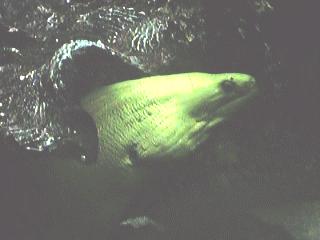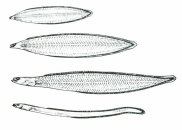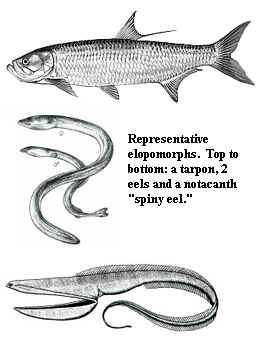
| Palæos: |  |
Unit 110: Teleostei |
| The Vertebrates | 100: Teleostei |
| Page Back | Unit Back | Unit Home | Unit References | Unit Cladogram | Glossary | Taxon Index |
| Page Next | Unit Next | Vertebrates Home | Vertebrate References | Vertebrate Cladograms | Bones | Timescale |
Teleost CladogramNEOPTERYGII | Teleostei |--Osteoglossomorpha `--Elopocephala |--Elopomorpha `--Clupeocephala |--Clupeomorpha | EUTELEOSTEI |
110.000 Overview |
Range: fr T, fl fr upK.
Phylogeny: Halecostomi::: Pachycormiformes + *: Osteoglossomorpha + Elopocephala.
Description: Mobile maxilla & premaxilla; median neural spines that are fused to the vertebrae; uroneurals (elongate posterior neural arch) stiffen upper lobe of caudal; fully homocercal.
Links: Teleostei, Teleostei; IWR: Taxa: Teleostei; Cycloid and Ctenoid Scales; Foto-album: Teleostei.
Note: Protrusible jaw evolved independently 4+ times. APW 040806.
 Osteoglossomorpha:
Aruana, elephant-nose fish.
Osteoglossomorpha:
Aruana, elephant-nose fish.
Range: from the Jurassic.
Phylogeny: Teleostei: Elopomorpha + *.
Description: supramaxilla absent; supraorbital absent; infraorbitals 4& 5 fused; primary bite between parasphenoid and tongue, supported by basihyals and glossohyal; 18 (or <17?) or fewer principal caudal fin rays and full neural spine in first preural centrum; 0-1 epurals (<3?); intestine passes to left of stomach; freshwater.
Links: Aruana; Osteoglossomorpha (Tree of Life); Osteoglossomorpha (Mikko's Phylogeny); APUS.RU (Russian); lecture13; The Journal of Vertebrate Paleontology (abstract, with some phylogeny); Related Research on Fishes (Page 1). APW 040806.
 Elopocephala:
Anaethalion?
Elopocephala:
Anaethalion?
Range: from the Jurassic.
Phylogeny: Teleostei:: Osteoglossomorpha + *: Elopomorpha + Clupeocephala.
Characters: 2 uroneurals extend anterior to 2nd ural vertebral centrum; epipleural intermuscular bones.
Links: Re- Comments on BIG DEAD FISH etc (remarks on phylogenetic position). APW 040806.
 Elopomorpha:
Tarpons, bonefish, eels, etc.
Elopomorpha:
Tarpons, bonefish, eels, etc.
Range: possibly from Jurassic, certainly from the middle Cretaceous.
Phylogeny: Elopocephala: Clupeocephala + *:
Description: Fusion of the angular (a dermal bone) and retroarticular (an endochondreal bone!); teeth on parasphenoid; rib-like epipleural intramuscular bones; reduction in uroneural bones in the tail; swim bladder not connected to ear; leptocephalus larvae; lack red blood cells (?! need to check this).
Image: Top: metamorphic stages of a leptocephalus larva (from top to bottom). Bottom: representative elopomorphs. Both from eels_etc.
 Note:
[1] Only clear character uniting this group is the bizarre larval form,
the leptocephalus. The following from Lecture
5 - Review osteogossomorph teleosts - sister group of rest of the extant
teleostei: Leptocephalus larvae have an elongate, highly compressed
and nearly transparent body. A series of v- or w-shaped myomeres covers most of
lateral area of the body. A transparent area extends dorsally and ventrally from
myomeres. Head small compared with body and rudiments of dorsal, anal and
pectoral fins are present. The unique structure of a leptocephalus can be
appreciated best in cross-section. The viscera lie along ventral margin in
narrow strand. Notochord, dorsal nerve cord and dorsal aorta lie together in
longitudinal axis of body about midway between dorsal and ventral margins. The
myomeres form thin layer on external to these.
Filling rest of interior of body is an acellular mucinous material bound
by continuous layer of epithelial cells. A
mucinous pouch separates viscera, notochord and two sides of body
musculature from each other and gives form and rigidity to body. The gut
lies in the ventral margin - normally straight although can be elaborated.
Interestingly no one has ever found food in gut of a leptocephalus - how can
they survive so long? Strong forwardly inclined fanglike teeth present in both
jaws - not homologous with adult teeth and disappear at metamorphosis. Some
evidence (from tracer work) that they derive nutrition from dissolved and minute
particulate matter in seawater. Buccal
lining is covered with microvilli. Leptocephali can grow very large
(certain notocanth larvae reach lengths of 18cm). Commonly spend several months
in marine plankton. Leptocephali of European freshwater eel, Anquilla anquilla,
is known to take about 3 years from hatching to metamorphosis.
During this time, leptocephalus grows but does not change much in
structure - in matter of a few days, leptocephalus transforms into juvenile with
habitat and adult way of life. Only character correspondence carried
through metamorphosis is the correspondence between myomeres and number of
vertebrae in adults. Surest way to link larva with adult is to find
metamorphosing specimens that combine adult characters with those of
larvae. [2] The same site has a few other
synapomorphies. Unfortunately, we are not good enough ichthyologists to
accurately describe them. [3] Leptocephalus larvae frequently
shrink during development. However, some members of the Notacanthiformes
(deep-sea benthic elopomorphs) do essentially all of their growing as
leptocephalus larvae. In 1930, a deep dredge caught such a
"larva" almost two meters long!
Note:
[1] Only clear character uniting this group is the bizarre larval form,
the leptocephalus. The following from Lecture
5 - Review osteogossomorph teleosts - sister group of rest of the extant
teleostei: Leptocephalus larvae have an elongate, highly compressed
and nearly transparent body. A series of v- or w-shaped myomeres covers most of
lateral area of the body. A transparent area extends dorsally and ventrally from
myomeres. Head small compared with body and rudiments of dorsal, anal and
pectoral fins are present. The unique structure of a leptocephalus can be
appreciated best in cross-section. The viscera lie along ventral margin in
narrow strand. Notochord, dorsal nerve cord and dorsal aorta lie together in
longitudinal axis of body about midway between dorsal and ventral margins. The
myomeres form thin layer on external to these.
Filling rest of interior of body is an acellular mucinous material bound
by continuous layer of epithelial cells. A
mucinous pouch separates viscera, notochord and two sides of body
musculature from each other and gives form and rigidity to body. The gut
lies in the ventral margin - normally straight although can be elaborated.
Interestingly no one has ever found food in gut of a leptocephalus - how can
they survive so long? Strong forwardly inclined fanglike teeth present in both
jaws - not homologous with adult teeth and disappear at metamorphosis. Some
evidence (from tracer work) that they derive nutrition from dissolved and minute
particulate matter in seawater. Buccal
lining is covered with microvilli. Leptocephali can grow very large
(certain notocanth larvae reach lengths of 18cm). Commonly spend several months
in marine plankton. Leptocephali of European freshwater eel, Anquilla anquilla,
is known to take about 3 years from hatching to metamorphosis.
During this time, leptocephalus grows but does not change much in
structure - in matter of a few days, leptocephalus transforms into juvenile with
habitat and adult way of life. Only character correspondence carried
through metamorphosis is the correspondence between myomeres and number of
vertebrae in adults. Surest way to link larva with adult is to find
metamorphosing specimens that combine adult characters with those of
larvae. [2] The same site has a few other
synapomorphies. Unfortunately, we are not good enough ichthyologists to
accurately describe them. [3] Leptocephalus larvae frequently
shrink during development. However, some members of the Notacanthiformes
(deep-sea benthic elopomorphs) do essentially all of their growing as
leptocephalus larvae. In 1930, a deep dredge caught such a
"larva" almost two meters long!
Links: sciencefest2001.pdf (see Cornett essay, p.6); lecture13; Monophyly of the Elopomorpha (group may be monophyletic); Elopomorpha; Abstracts_Lavoué (group is not monophyletic); eels_etc. APW 040806.
Range: from the Cretaceous.
Phylogeny: Elopocephala: Elopomorpha + *: Clupeomorpha + Euteleostei.
Description: $ mandibular quadrate facet formed only by angular & articular, excluding retroarticular [T00]; pharyngeal tooth plates (when present) fused with endoskeletal gill arch elements (1st three pharyngobranchials) (contra, [T00]); $ neural arch of 1st ural centrum reduced or absent, or fused with other elements [T00].
Links: Clupeocephala after Taverne, 2000; Taverne; Link to NCBI Front Page (links to recent articles); Goulmimichthys arambourgi Cavin (abstract with some phylogenetic fine points).
References: Taverne (2000) [T00]. APW 040806.
Clupeomorpha: herring, sardines, anchovies.
Range: fr K.
Phylogeny: Clupeocephala: Euteleostei + *.
Description: Swim bladder penetrates exoccipital. 2nd hypural fused w ural vertebra 1, while 1st hypural free proximally.
Links: Herring
APW 040806.
| Page Back | Unit Home | Glossary | Page Top | Page Next |
checked ATW060209